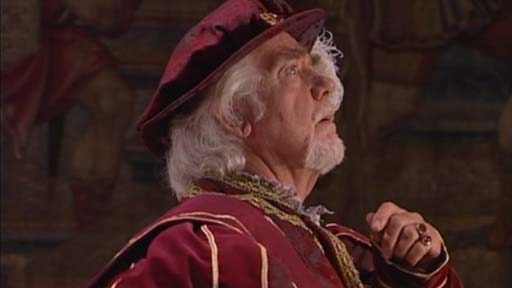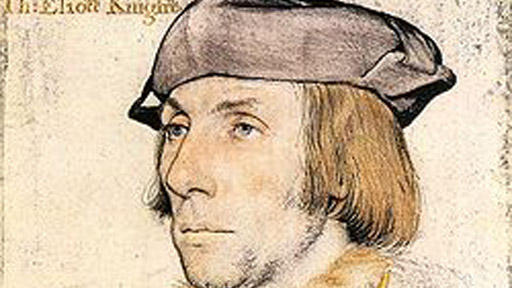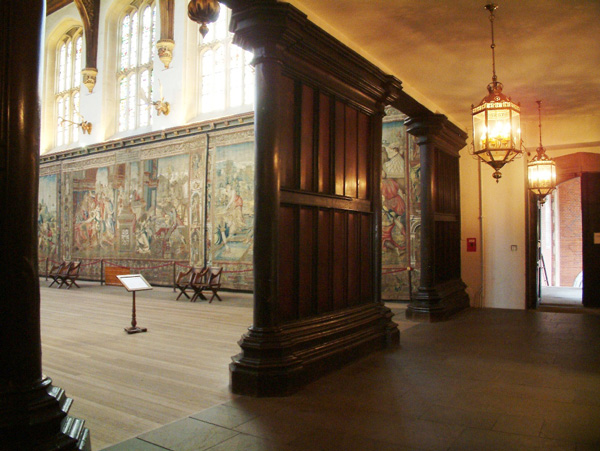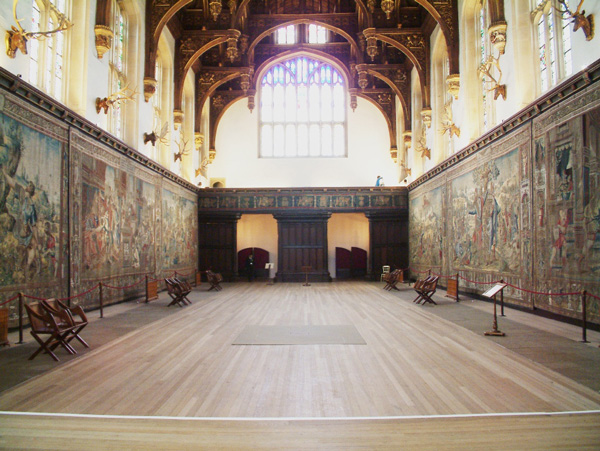The Great Hall at Hampton Court Palace
Dr Kent Rawlinson & Professor Tom Betteridge
The Great Hall of Hampton Court Palace is the only surviving hall built by Henry VIII. At first-floor level, it stands above two large cellars and was principally constructed between 1532 and 1535. The Great Hall either completely replaced a medieval ground-floor hall or may, conceivably, be a very substantial rebuilding of an earlier first-floor hall built by Cardinal Wolsey. Certainly, in the early 1530s a conscious decision was made to dramatically remodel the Great Hall in order that Hampton Court could accommodate the full royal court for the celebration of principal court festivals, such as Christmas, Twelfth-Night and Easter. These festivals required large spaces to accommodate lavish court ceremony and entertainments (The Great Hall and other greater chambers); a Chapel Royal to permit elaborate liturgical celebration; and a substantial body of lodgings, served by a respectively large wing of kitchens and household offices, to accommodate the court and its guests.
Hampton Court Palace's buildings Curator Kent Rawlinson talks about the Great Hall
The Great Hall is 106 ft. long and 40 ft. wide. In common with most medieval halls, the principal entrance(s) into the hall are through the Screen’s Passage at the low end of the hall. This is accessed from two staircases; the south stairs (now the Great Hall Stairs), used by courtiers and guests at court, run up from the two principal courtyards of the palace; and the north stairs (now the Buttery Stairs), used by the household officers serving the hall, run up from a long northern range of kitchen and offices. Over the Screen’s Passage is a minstrels’ gallery.
The high end of the Great Hall, again in common with medieval halls, is articulated by a raised dais. A doorway, centrally placed on the axis of the hall, communicates between this dais and the neighbouring Great Watching Chamber. Both the high end of the Great Hall and the Great Watching Chamber communicate with, and were served from, the Hall Palace (now the Horn Room) that possesses a further stair leading down to the service range.
The Great Watching Chamber served as an extension of the Great Hall, for the dining, as well as an antechamber or waiting room (the literal meaning of ‘watching chamber’) attendant upon Henry VIII’s Privy Chambers whose ‘public’ entrance it contained. Access to these ‘privy’ or private apartments (rebuilt in the eighteenth century) was controlled by court officers and restricted to members of the ‘Privy Chamber’ and ‘Privy Council’, as well as select invitees. On Sundays and great feast days, Henry VIII and leading members of his court liturgically processed to the Chapel Royal through the Great Watching Chamber and along the galleries linking it to the first-floor Holyday Closets in the chapel’s western gallery.
The Great Hall at Hampton Court Palace was used both for high ceremony and fantastic entertainments, as well as for the comparatively mundane and domestic business of the court life. At its most ceremonial it was a ‘stage’ upon which Henry could ‘play’ the role of magnificent Renaissance monarch. The extraordinarily expensive tapestries that decorated the walls of the hall on such occasions communicated both political messages, in their iconography, but also the wealth of the English court, by their use of materials. At such times it was an inherently theatrical space, although the ‘drama’ that took place in it was often deadly serious. On a day-to-day basis, when the court was in residence, the hall operated much more simply as an ante-room for those members of the court of insufficient status to gain access to, or to linger at length in, the Great Watching Chamber. It is likely, too, that the Great Hall was used to serve basic meals, twice daily, to the hundreds of members of the royal household who served the court.
Greg Walker talks about the 2010 workshops in the Great Hall
On days of court entertainment or high ceremony, especially when the king or leading courtiers were formally present, the Great Hall was, then, a very hierarchical space, criss-crossed with symbolic boundaries and barriers. By contrast, on a day-to-day basis, the Great Hall was a common area of the palace, accessible to most members of the household, that probably acted as an important, but informal, shared space for those at court. To gain access to the king from this ‘public’ space required the status, first, to enter the Great Watching Chamber and, second, to be permitted into Privy Chambers. Such status might derive from noble rank, from appointment as a household or court officer, or by particular invitation or necessity. In The Play of the Weather Merry Report is appointed as a court officer and one of his principal roles is to manage the different ways in which the various suitors access or approach Jupiter. Only two are actually allowed to directly address Jupiter, The Gentleman and The Merchant. The Gentlewoman, however, clearly approaches sufficiently close for the God to view her and reject her advances.
An example of way in which status was articulated and policed was the use or control of light. The dais which marks the upper end of the Great Hall is better lit, by a large bay window, than the body of the hall. At night, who was lit, what kind of lights were used, candles, lanterns or torches, were symbolically charged questions. When Merry Report on his entrance requests that, ‘Brother, holde up your torch a little higher’ (98), he is asking for better light but also implicitly claiming the right to torch-light. Given the high status of torches and their relative brightness Merry Report’s demand immediately suggests his importance as a character. This moment in The Play of the Weather reflects Heywood’s consistent awareness of the dramatic possibilities offered by the practicalities of indoor playing in relation to lighting. For example, in Johan Johan Heywood plays with the comic possibilities offered by light and darkness. Johan Johan stages a confrontation between John, his wife Tyb and her lover, a priest called Sir John. During the final scene Tyb sends John to chaff a candle by the fire while she sits in the relative darkness with her priestly lover.
Sir John: What dost, John John, I thee require?
John: I chaff the wax here by the fire.
Tyb: Here is good drink, and here is good pie.
Sir John: We fare very well, thanked be our lady.
Tyb: Look how the cuckold chaffed the wax that is hard,
And for his life dareth not to look hitherward. (501-506).
In this scene Heywood reverses the norms of courtly lighting. While it is John who is by the fire chaffing his candle the real action is in the relative dark of the table. Light in this scene is associated not with status but rather with humiliating cuckoldry. Indeed throughout the play John is depicted as a creator of light whose reward is to be disempowered by those characters, Tyb and Sir John, who prefer to remain in the gloom.
During ceremonies and entertainments, the Great Hall at Hampton Court Palace was lit by a large hearth, hundreds of candles, and personal torchbearers. Dramatic displays of gold plate, arranged as symbols of status on tall sideboards, would have reflected and amplified the light provided by candles and torches. At the same time the nature of Henry’s court meant that darkness and shade were also important aspects of the Great Hall. Where the light shone indicated status but, as Johan Johan suggests, there was also acknowledgement by people like Heywood that it was often in the darkness that other sources of power and influence lay hidden.
References: The Plays of John Heywood edit. Richard Axton, Peter Happé (Cambridge, 1991).













